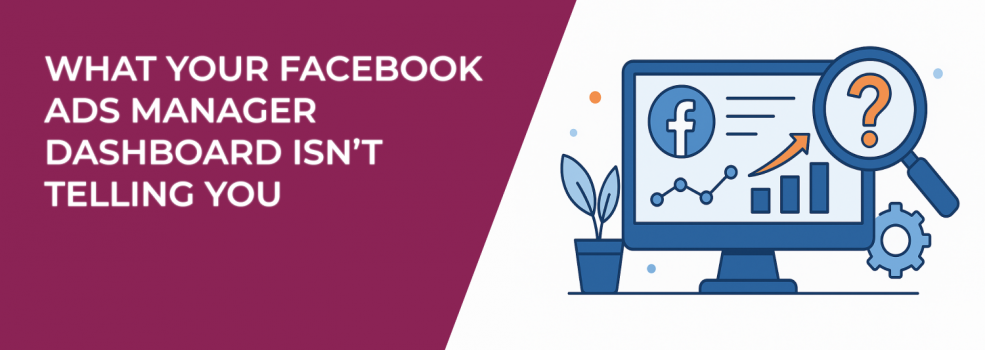Your Ads Manager dashboard looks fine at first glance. Your ROAS is solid, CTRs are steady, and the budget is holding. But let’s be real: those surface numbers don’t tell the full story.
The problem? Most advertisers only look at what Meta highlights. And that means you might miss the early signs of wasted spend, broken funnels, or scaling issues.
Here are the insights your Facebook Ads Manager isn’t showing — and how to uncover them.
1. “Stable” CPAs Might Be Masking Inconsistent Delivery
You might be tracking your cost per result, but are you looking at how consistent it is?
Your dashboard won’t flag major fluctuations. And those day-to-day swings in CPA, ROAS, or CTR can quietly hurt your campaign.
Here’s what to look at instead:
-
Day-to-day volatility in cost or performance metrics. A steady average CPA might be hiding spikes that are making your campaigns unpredictable. Look at daily costs, not just averages.
-
Performance across 3-, 5-, and 7-day moving averages. These trends help you identify if things are improving or declining steadily, rather than reacting to a single good or bad day.
-
Any pattern of "cheap days" followed by spikes. If performance suddenly drops after a strong day, it could mean the algorithm is overspending trying to chase more conversions.
This kind of inconsistency often means your ad set is struggling to stabilize or exit the learning phase. If that sounds familiar, here’s a useful read: Why You See 'Ad Set May Get Zero' on Facebook and How to Fix It.
2. You Don’t See Where Meta Is Really Spending Your Budget
If you’re running Advantage+ placements, you’re letting Meta auto-optimize. But where is that budget actually going?
Dig into breakdowns like:
-
Placement (Feed, Reels, Stories, Audience Network). This tells you where your ad is being shown. Some placements get more clicks, but others may convert better.
-
Device type (iOS vs Android). Conversion rates and behavior can vary a lot between mobile platforms.
-
Ad performance by placement. A creative that works well in the Feed might flop in Stories or Reels. Knowing which one performs best helps you optimize your creative format.
Sometimes, Meta will push 80%+ of spend to a low-converting placement because it gets cheaper clicks. That’s why checking placement-level performance is key. You can learn more in Facebook Ad Placement Strategy: What Drives Clicks and Conversions.
3. Link Clicks ≠ Landing Page Views
A high CTR might seem great. But how many people actually landed on the page and stayed?
Don’t just track Link Clicks. Look at:
-
Landing Page Views (LPVs). This filters out accidental clicks and users who bounce before the page loads.
-
Bounce rates and session duration in GA4. Are users spending enough time to actually read, scroll, or interact with your offer?
-
Custom Pixel events like scroll depth or time-on-site. These micro-metrics tell you if users are engaging after they click.
You might have a low CPC but terrible post-click engagement. And that can kill conversions without showing up in your Ads Manager.
If your ads get traffic but don’t convert, this guide helps: Facebook Ads Not Converting: How to Fix It.
4. Broad Targeting Hides Who’s Actually Converting
Broad works. But it doesn’t mean everyone in the audience is converting.
Here’s how to dig deeper:
-
Use Breakdown > Demographics (age, gender, location). These filters can show you which groups are actually performing best within your broad audience.
-
Add UTMs to segment by ad, placement, or creative in GA4. You’ll get a clearer picture of performance by campaign element in analytics.
-
Use tools like LeadEnforce to enrich audiences and understand segments. This helps you build more specific audiences based on behavior and interest, not just broad categories.
Sometimes just one small slice of the audience is pulling all the weight. You won’t see that unless you get more granular with your data.
Also check out Facebook Ad Targeting 101: How to Reach the Right Audience if you're ready to refine your audience strategy.
5. You’re Not Measuring What Happens After the Click
Meta reports stop at the conversion event. But what about the steps leading up to that?
Use these tools to see beyond the dashboard:
-
Session replays (Hotjar, Smartlook). These tools let you watch how users interact with your landing page. You’ll see if they get stuck or leave immediately.
-
Funnel drop-off reports in GA4. Identify exactly where users drop off in your funnel — whether it's on form fields, CTA buttons, or pricing sections.
-
Micro-conversions like button clicks, form interaction, or time on key pages. These small steps often predict if someone is likely to convert later, and they help you spot early funnel issues.
You don’t need to wait for conversion data to understand what’s working. Behavior signals can show you if the offer or the landing experience needs work.
And if you want to scale without guessing, try automated rules to react faster to the right data points. This guide shows how to set them up: How to Use Automated Rules to Improve Facebook Campaign Efficiency.
Final Check: Your Dashboard Isn’t Broken — It’s Just Not Enough
Facebook Ads Manager gives you the basics. But it leaves out the most important context.
If you’re serious about improving performance, look beyond the standard columns. Break things down. Add third-party insights. Watch for patterns, not just averages.
Because the real insights don’t live in the default view.

